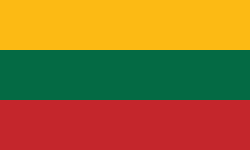Varėna
 |
The town was founded in 1862 near the Warsaw – Saint Petersburg Railway, 4 km south of Sena Varėna (Old Varėna). At that time it was a small settlement, but following steady development it eventually became the center of the district. In the interbellum period, following World War I, the town was annexed by Poland, and renamed Orany. It was located near the then Polish-Lithuanian border, in the Wilno-Troki County (Powiat wileńsko-trocki) of the Wilno Voivodeship. In 1939, following the German-Soviet Invasion of Poland, Varėna was returned to Lithuania.
On September 9, 1942, all the Jews of the town of Varėna were collected in the local synagogue. On that day, even though the Germans had tried to prevent him from doing so, the priest Jonas Gylys entered the synagogue and encouraged the Jews to be brave in their last hours rather than convert to Christianity.
On the following day (or, according to another source, on the 9th itself) all of the Jews were taken from the synagogue to Eserekiai - a grove of trees near the village of Druckūnai, 1.5 km from the town, on the side of the road leading to the village. Two large pits had been dug there 25 m apart, one for the men and one for the women. Germans forced the victims in groups toward the pits and shot them there.
According to the report of Karl Jaeger, commander of Einsatzkommando 3A, 831 Jews from Varėna (and the surrounding areas) – 541 men, 149 women, and 141 children – were killed on that day.
In 1946 around 2000 Poles were repatriated to Poland.
Following industrialization in the 1970s, the town grew rapidly. Currently there are 9,240 residents in Varėna. The Varėna district is the largest and most forested region in Lithuania.
Map - Varėna
Map
Country - Lithuanian_Soviet_Socialist_Republic_(1918–1919)
 |
 |
| Flag of Lithuania | |
Germany had lost World War I and signed the Compiègne Armistice on 11 November 1918. Its military forces then started retreating from the former Ober Ost territories. Two days later, the government of the Soviet Russia renounced the Treaty of Brest-Litovsk, which had assured Lithuania's independence. Soviet forces then launched a westward offensive against Estonia, Latvia, Lithuania, Poland and Ukraine in an effort to spread the global proletarian revolution and replace national independence movements with Soviet republics. Their forces followed retreating German troops and reached Lithuania by the end of December 1918.
Currency / Language
| ISO | Currency | Symbol | Significant figures |
|---|---|---|---|
| EUR | Euro | € | 2 |
| ISO | Language |
|---|---|
| LT | Lithuanian language |
| PL | Polish language |
| RU | Russian language |















